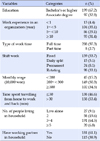1. Greenhaus JH, Collins KM, Shaw JD. The relation between work-family balance and quality of life. Journal of Vocational Behavior. 2003; 63(3):510–531. DOI:
10.1016/S0001-8791(02)00042-8.

2. Haar JM, Russo M, Suñe A, Ollier-Malaterre A. Outcomes of work-life balance on job satisfaction, life satisfaction and mental health: A study across seven cultures. Journal of Vocational Behavior. 2014; 85(3):361–373. DOI:
10.1016/j.jvb.2014.08.010.

3. Virick M, Lilly JD, Casper WJ. Doing more with less: An analysis of work life balance among layoff survivors. Career Development International. 2007; 12(5):463–480. DOI:
10.1108/13620430710773772.
4. Carlson DS, Grzywacz JG, Ferguson M, Hunter EM, Clinch CR, Arcury TA. Health and turnover of working mothers after childbirth via the work-family interface: An analysis across time. Journal of Applied Psychology. 2011; 96(5):1045–1054. DOI:
10.1037/a0023964.

5. Zhao X, Sun T, Cao Q, Li C, Duan X, Fan L, et al. The impact of quality of work life on job embeddedness and affective commitment and their co effect on turnover intention of nurses. Journal of Clinical Nursing. 2013; 22(5-6):780–788. DOI:
10.1111/j.1365-2702.2012.04198.x.

6. De Castro A, Fujishiro K, Rue T, Tagalog E, Samaco Paquiz L, Gee G. Associations between work schedule characteristics and occupational injury and illness. International Nursing Review. 2010; 57(2):188–194. DOI:
10.1111/j.1466-7657.2009.00793.x.



7. Folkard S, Lombardi DA. Modeling the impact of the components of long work hours on injuries and “accidents”. American Journal of Industrial Medicine. 2006; 49(11):953–963. DOI:
10.1002/ajim.20307.


8. Rogers AE, Hwang W-T, Scott LD, Aiken LH, Dinges DF. The working hours of hospital staff nurses and patient safety. Health Affairs. 2004; 23(4):202–212. DOI:
10.1377/hlthaff.23.4.202.


9. Anxo D, Boulin J-Y, Cabrita J, Vermeylen G. Working time patterns for sustainable work. ; . Luxemburg: Publications Office of the European Union;2017.
10. Tausig M, Fenwick R. Unbinding time: Alternate work schedules and work-life balance. Journal of Family and Economic Issues. 2001; 22(2):101–119. DOI:
10.1023/A:1016626028720.
11. Keeton K, Fenner DE, Johnson TR, Hayward RA. Predictors of physician career satisfaction, work-life balance, and burnout. Obstetrics & Gynecology. 2007; 109(4):949–955. DOI:
10.1097/01.AOG.0000258299.45979.37.


12. Yildirim D, Aycan Z. Nurses' work demands and work-family conflict: A questionnaire survey. International Journal of Nursing Studies. 2008; 45(9):1366–1378. DOI:
10.1016/j.ijnurstu.2007.10.010.


13. Hospital Nurses Association (KR). A survey on hospital nursing staffing(2017). Business report for Hospital Nurses Association. Seoul: Hospital Nurses Association;2018.
14. Ministry of Health and Welfare (KR). National medical care resources and utilization survey. Osong: Korea Health Industry Development Institute;2017.
15. Green F, Mostafa T. Trends in job quality in Europe: A report based on the fifth European Working Conditions Survey. Luxemburg: Eurofound;2012.
16. Parent-Thirion A, Biletta I, Cabrita J, Vargas Llave O, Vermeylen G, Wilczyńska A, et al. Sixth European working condition survey-overview report. Luxemburg: Eurofound;2016.
17. Kim H, Moon C-G. Empirical analysis of work-life balance: using the 4th and 5th Korean working conditions surveys. Korean Social Security Studies. 2019; 35(2):167–206.
18. Valcour M. Work-based resources as moderators of the relationship between work hours and satisfaction with work-family balance. Journal of Applied Psychology. 2007; 92(6):1512–1523. DOI:
10.1037/0021-9010.92.6.1512.

19. Trinkoff AM, Johantgen M, Storr CL, Gurses AP, Liang Y, Han K. Nurses' work schedule characteristics, nurse staffing, and patient mortality. Nursing Research. 2011; 60(1):1–8. DOI:
10.1097/nnr.0b013e3181fff15d.


20. Craig L, Powell A. Non-standard work schedules, work-family balance and the gendered division of childcare. Work, Employment and Society. 2011; 25(2):274–291. DOI:
10.1177/0950017011398894.

21. Nelson MF, Tarpey RJ. Work scheduling satisfaction and work life balance for nurses: the perception of organizational justice. Academy of Health Care Management Journal. 2010; 6(1):25–36.
22. Karhula K, Koskinen A, Ojajärvi A, Ropponen A, Puttonen S, Kivimäki M, et al. Are changes in objective working hour characteristics associated with changes in work-life conflict among hospital employees working shifts? A 7-year follow-up. Occupational and Environmental Medicine. 2018; 75(6):407–411. DOI:
10.1136/oemed-2017-104785.



23. Albertsen K, Rafnsdóttir GL, Grimsmo A, Tómasson K, Kauppinen K. Workhours and worklife balance. Scandinavian Journal of Work, Environment & Health. 2008; 34:5 Suppl. 14–21.
24. Liang H-F, Lin C-C, Wu K-M. Breaking through the dilemma of whether to continue nursing: Newly graduated nurses' experiences of work challenges. Nurse Education Today. 2018; 67:72–76. DOI:
10.1016/j.nedt.2018.04.025.

25. Reddy NK, Vranda M, Ahmed A, Nirmala B, Siddaramu B. Work-Life balance among married women employees. Indian Journal of Psychological Medicine. 2010; 32(2):112–118. DOI:
10.4103/0253-7176.78508.



26. Siegrist J. Adverse health effects of high-effort/low-reward conditions. Journal of Occupational Health Psychology. 1996; 1(1):27–41. DOI:
10.1037/1076-8998.1.1.27.


27. Siegrist J, Starke D, Chandola T, Godin I, Marmot M, Niedhammer I, et al. The measurement of effort-reward imbalance at work: European comparisons. Social Science & Medicine. 2004; 58(8):1483–1499. DOI:
10.1016/S0277-9536(03)00351-4.







 PDF
PDF ePub
ePub Citation
Citation Print
Print







 XML Download
XML Download